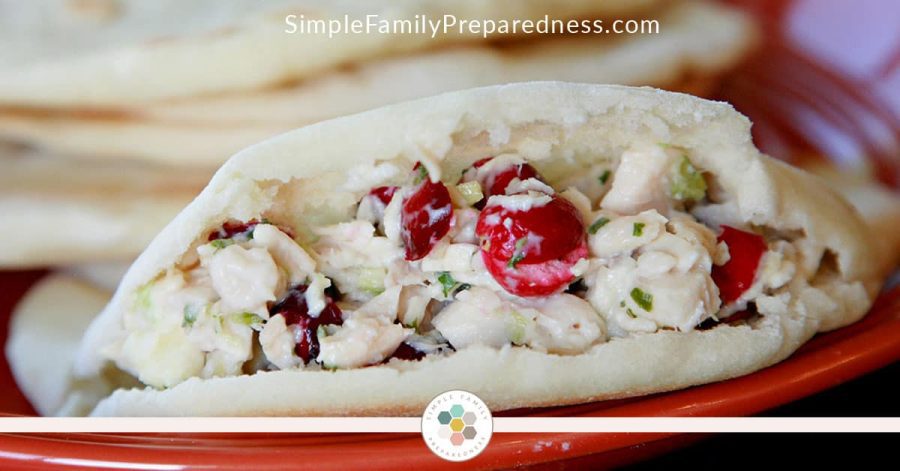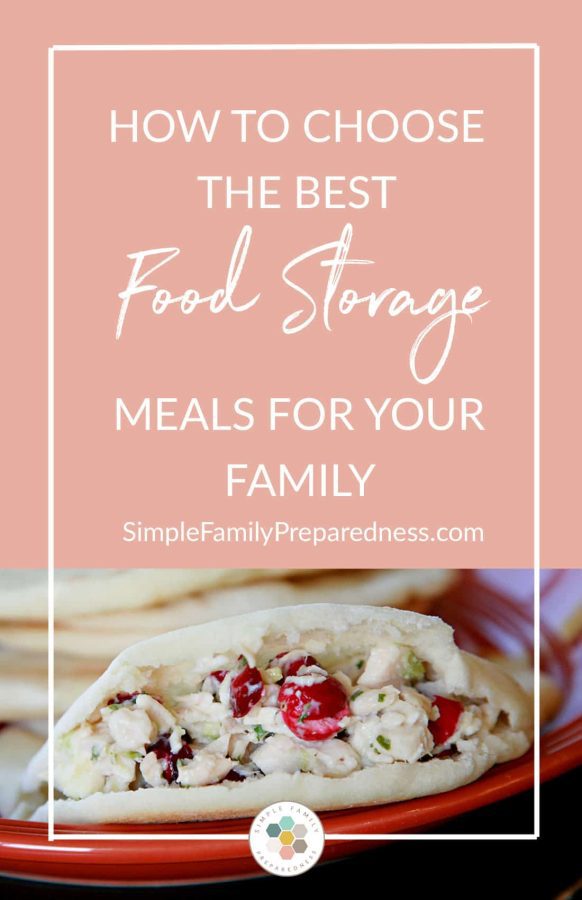Planning the food you will store around food storage meals is a smart thing to do! When you build your food storage based on meals, you know exactly what you are going to be feeding your family. You don’t have to wonder or learn how to use new foods or try to put a meal together with wheat, beans, and powdered milk–for weeks in a row.

But the calculators that tell you to store “x” pounds of wheat and “x” pounds of beans are simpler, right? Trying to come up with food storage meals for your family can feel daunting. Here are some questions you can ask yourself and some other ideas that should help you choose food storage meals for your family! Feel free to add your own ideas in the comments as well!
Figure out WHY You Want to Store Food
Are you most worried about an earthquake? A flood? Job loss? Evacuation? Or maybe shopping EVERY. SINGLE. WEEK. stresses you out. Knowing your eventual goal will help you to know what types of food are best to store.
For example, if you need to be prepared for a possible evacuation, you will need food storage meals that are lightweight, compact, and easy to prepare. But if you simply want to be able to skip grocery shopping every once in a while, well, then you’ll want to plan food storage meals you know your family likes.
Does the Food in Your Freezer Count as Food Storage?
Some people only count completely shelf stable food as “food storage.” Others include the food in their freezer. What will you do?
Again, some of this depends on what you are preparing for, right? If it’s a job loss, a power outage isn’t likely to be an issue. But if you live in earthquake territory it might be!
If you choose to count your freezer as food storage, then you can use things like frozen chicken and cheese in the food storage meals you choose.
Decide How Much Variety You Want
I’m picky in the evenings. I can’t stand to eat the same meal more than once or twice a month. I NEED variety. So, I need at least 14 food storage meals that would work for dinner. That way I only eat the same meal every two weeks.
But I’m less picky (who knows why) with breakfast and lunch. I’m okay with three or four breakfast meals and three or four lunch meals.
What is your family like? Think about it so that you know how many food storage meals you need to find and plan for.
Now that you know what you goals are, what counts as “food storage” for your family, and how many meals you need, it is time to start looking for your actual food storage meals. Here are some tips as you do so:
Pay Attention to What You Eat for a Month or so
What meals does everyone in your family love? Do you generally prefer chicken, beef, or pork? Rice, pasta, or breads and rolls?
Are there any meals you already make that use 100% shelf stable ingredients (all canned goods)? (Don’t forget any side dishes you make.)
Do you make any meals that use very few ingredients? Calculating out how much of each ingredient you will need to make a meal twice a month for three months (or whatever you decide), will be easier the fewer ingredients each recipe has.
Pay attention and make some notes for yourself. Then do your best to build your food storage meals around things you know your family will enjoy.
What Is Your Budget?
If you are ready to significantly invest in food storage, then truthfully, almost all the meals your family eats right now can be made with shelf stable ingredients when you use freeze dried meat and produce. The meals you currently enjoy and love can become your family’s food storage meals with very little (or sometimes no) change in taste.
But freeze dried foods are expensive–especially meat.
If your budget is more limited, you will need to stick to food storage meals that use canned meat and veggies, so look for recipes that use those. You will also want to go heavy on rice, pasta, and beans. These three items are filling and are the least expensive items you can get.
Avoid Recipes That Use Less Than a Whole Can of Any Ingredient
If a recipe calls for a half can of stewed tomatoes, what will you do with the other half–especially if you don’t have power? Try to choose recipes that use entire cans of the ingredients they call for.
*Note – This is true for canned items at the grocery store, but not freeze dried and dehydrated items. Freeze dried and dehydrated items have a shelf life of a few months (or even a full year) beyond when you open them.
Ask around!
If you are a part of any preparedness or food storage Facebook groups, ask if anyone has a recipe or two they love. (You can join my basic Facebook group HERE and my more advanced one HERE)
Ask your friends, family, and neighbors. Even if they aren’t into “food storage,” you can ask if they have any simple recipes that use very few ingredients or if they have any that use lots of canned ingredients.
Now that you have found and decided on some food storage meals, there are two things left to do:
Make Your Food Storage Meals!
Once you’ve chosen a food storage meal, make it once to be certain your family will eat it. Then depending on how well they like it, you can keep it on the list or remove it.
If you keep it on your food storage meals list, decide how often you make this meal for your family in order to rotate through–and not waste–the ingredients. If they loved it, maybe you’ll make it twice a month! If they only sorta like it, maybe you will make it twice a year.
Just make a choice and write it down so you remember. This will ensure that your food storage is usable should you ever have to use it. Plus, it will take some of the stress out of meal planning!
Make a Plan
Deciding on the best food storage meals for your family won’t do you any good if you don’t have the ingredients for those meals in your home.
But before you start purchasing anything, you need to figure out exactly what you need to purchase.
Simply list out the ingredients you need for each dinner recipe once. Then add any ingredients called for in multiple recipes together. For example if you have more than one recipe that calls for salt, add all those together. If you have more than one recipe that calls for canned tomatoes, add those together.
Repeat this process for your breakfast and then your lunch recipes.
Now you know what you need for a one week supply of food for your family!
But most people want to (at least eventually) store more than a one week supply (although a one week supply is a GREAT place to begin).
However, if you want to know what you need for a larger supply, start by multiplying the ingredient totals by how many times you will eat each meal in a month. Here are some calculations that will help:
For breakfast/lunch, most people will choose 2-4 recipes:
- If you chose 2 recipes, multiply each ingredient on your list by 15
- If you chose 3 recipes, multiply each ingredient on your list by 10
- If you chose 4 recipes, multiply each ingredient on your list by 7.5
For dinner, most people will choose 5-14 recipes:
- If you chose 5 recipes, multiply each ingredient on your list by 6
- If you chose 7 recipes, multiply each ingredient on your list by 4.3
- If you chose 10 recipes, multiply each ingredient on your list by 3
- If you chose 14 recipes, multiply each ingredient on your list by 2.15
Now you know what you need for a one month supply of food for your family!
If you want a two month supply, double that number for each ingredient. If you want a three month supply, triple it. If you want a year supply, multiply it by 12.
Once you know exactly what you need to buy, decide how you will go about doing it. Will you buy a certain amount each month? Each week? Will you buy it all at once?
One tip–If you are buying the ingredients for your food storage meals over time (some every month, week, etc.), don’t buy all the ingredients for a full supply of one meal at a time.
For example, let’s say your goal is a three month supply of food storage meals and you have chosen 14 dinners. Instead of buying all the ingredients for a three month supply of spaghetti (seven spaghetti meals) this month and then all the ingredients for a three month supply of chili next month, buy enough to make seven different food storage meals once this month.
It is the same number of meals (seven), but if you have to use your food storage before you’ve built up your full supply you will have a variety of meals instead of having to eat the same one over and over and over.
Your Tips
What tips do you have? What has helped you as you’ve built (or thought about building) a food storage? What tips have you gotten from others? Leave them in the comments below!
IF YOU THINK THIS POST COULD HELP SOMEONE YOU KNOW, PIN IT!
(OR SHARE IT WITH THE PINK BUTTONS BELOW)

Becky is a wildlife enthusiast and pet and livestock care expert with a diploma in canine nutrition. With over a decade of experience in animal welfare, Becky lends her expertise to Simple Family Preparedness through insightful info about pets, livestock, bee keeping, and the practicalities of homesteading.





When I first started preparing in 2014, some of these tasks seemed daunting. I had a very little freezer and no space to store. Since then I have started canning, dehydrating, shopping sales and freezing meals, thanks to the Internet, Pinterest, and with help from people like Misty Marsh. The task of preparing for any situation is now a way of life and each day I am adding and fine tuning. I am grateful to all who have brought me to this point and hope to help and encourage others along the way.
What a great little story Sandi! And isn’t that what it is all about? Starting small, being consistent and sharing what we learn? THANK YOU!